FIAT 124 SPIDER 2016 2.G Manual Online
Manufacturer: FIAT, Model Year: 2016, Model line: 124 SPIDER, Model: FIAT 124 SPIDER 2016 2.GPages: 216, PDF Size: 3.1 MB
Page 81 of 216
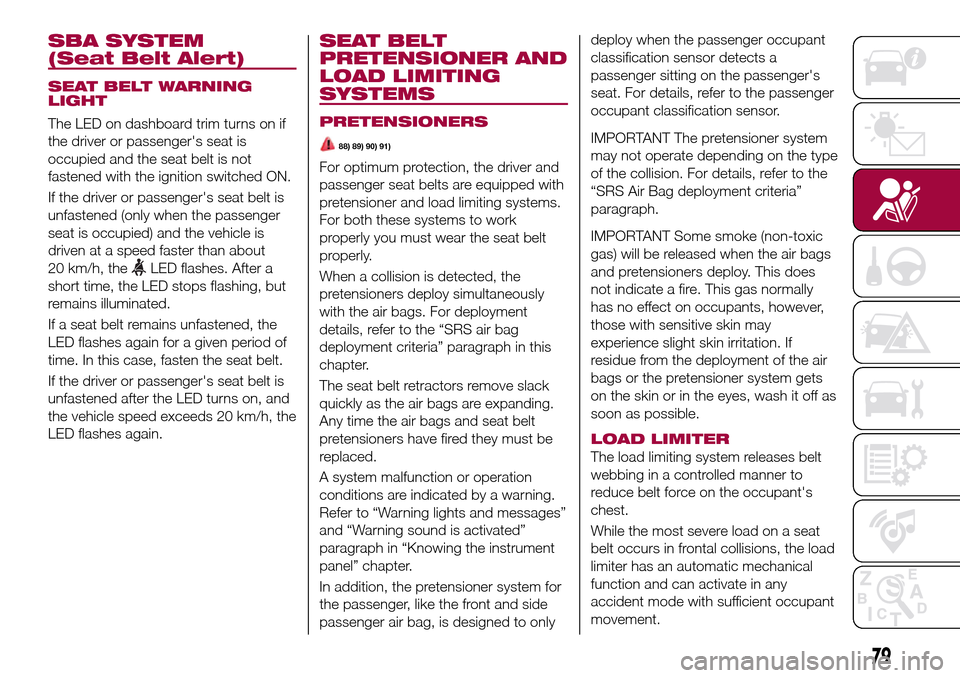
SBA SYSTEM
(Seat Belt Alert)
SEAT BELT WARNING
LIGHT
The LED on dashboard trim turns on if
the driver or passenger's seat is
occupied and the seat belt is not
fastened with the ignition switched ON.
If the driver or passenger's seat belt is
unfastened (only when the passenger
seat is occupied) and the vehicle is
driven at a speed faster than about
20 km/h, the
LED flashes. After a
short time, the LED stops flashing, but
remains illuminated.
If a seat belt remains unfastened, the
LED flashes again for a given period of
time. In this case, fasten the seat belt.
If the driver or passenger's seat belt is
unfastened after the LED turns on, and
the vehicle speed exceeds 20 km/h, the
LED flashes again.
SEAT BELT
PRETENSIONER AND
LOAD LIMITING
SYSTEMS
PRETENSIONERS
88) 89) 90) 91)
For optimum protection, the driver and
passenger seat belts are equipped with
pretensioner and load limiting systems.
For both these systems to work
properly you must wear the seat belt
properly.
When a collision is detected, the
pretensioners deploy simultaneously
with the air bags. For deployment
details, refer to the “SRS air bag
deployment criteria” paragraph in this
chapter.
The seat belt retractors remove slack
quickly as the air bags are expanding.
Any time the air bags and seat belt
pretensioners have fired they must be
replaced.
A system malfunction or operation
conditions are indicated by a warning.
Refer to “Warning lights and messages”
and “Warning sound is activated”
paragraph in “Knowing the instrument
panel” chapter.
In addition, the pretensioner system for
the passenger, like the front and side
passenger air bag, is designed to onlydeploy when the passenger occupant
classification sensor detects a
passenger sitting on the passenger's
seat. For details, refer to the passenger
occupant classification sensor.
IMPORTANT The pretensioner system
may not operate depending on the type
of the collision. For details, refer to the
“SRS Air Bag deployment criteria”
paragraph.
IMPORTANT Some smoke (non-toxic
gas) will be released when the air bags
and pretensioners deploy. This does
not indicate a fire. This gas normally
has no effect on occupants, however,
those with sensitive skin may
experience slight skin irritation. If
residue from the deployment of the air
bags or the pretensioner system gets
on the skin or in the eyes, wash it off as
soon as possible.
LOAD LIMITER
The load limiting system releases belt
webbing in a controlled manner to
reduce belt force on the occupant's
chest.
While the most severe load on a seat
belt occurs in frontal collisions, the load
limiter has an automatic mechanical
function and can activate in any
accident mode with sufficient occupant
movement.
79
Page 82 of 216
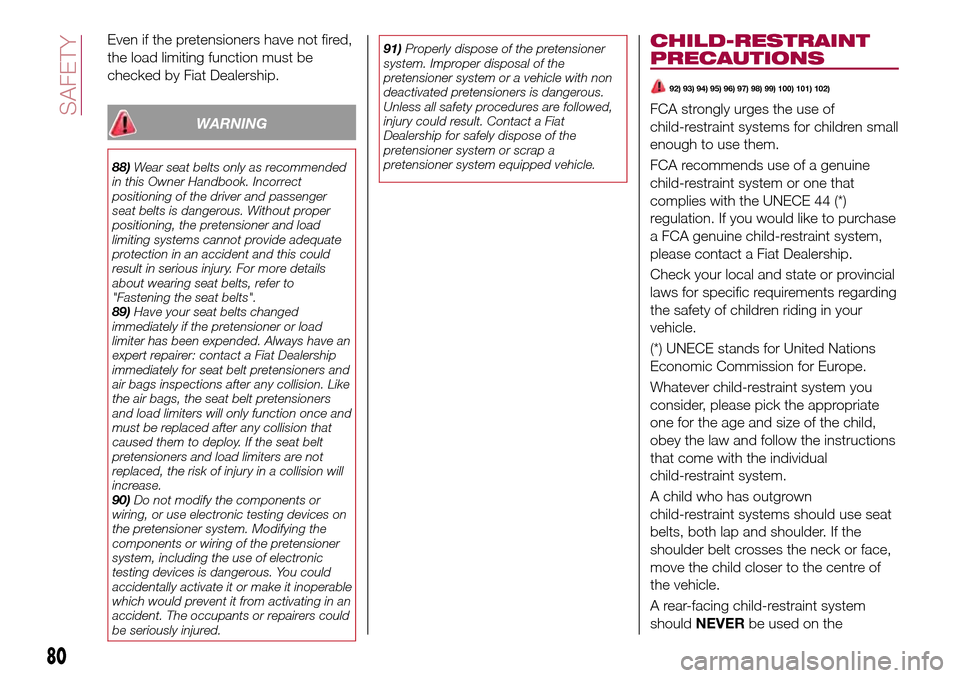
Even if the pretensioners have not fired,
the load limiting function must be
checked by Fiat Dealership.
WARNING
88)Wear seat belts only as recommended
in this Owner Handbook. Incorrect
positioning of the driver and passenger
seat belts is dangerous. Without proper
positioning, the pretensioner and load
limiting systems cannot provide adequate
protection in an accident and this could
result in serious injury. For more details
about wearing seat belts, refer to
"Fastening the seat belts".
89)Have your seat belts changed
immediately if the pretensioner or load
limiter has been expended. Always have an
expert repairer: contact a Fiat Dealership
immediately for seat belt pretensioners and
air bags inspections after any collision. Like
the air bags, the seat belt pretensioners
and load limiters will only function once and
must be replaced after any collision that
caused them to deploy. If the seat belt
pretensioners and load limiters are not
replaced, the risk of injury in a collision will
increase.
90)Do not modify the components or
wiring, or use electronic testing devices on
the pretensioner system. Modifying the
components or wiring of the pretensioner
system, including the use of electronic
testing devices is dangerous. You could
accidentally activate it or make it inoperable
which would prevent it from activating in an
accident. The occupants or repairers could
be seriously injured.91)Properly dispose of the pretensioner
system. Improper disposal of the
pretensioner system or a vehicle with non
deactivated pretensioners is dangerous.
Unless all safety procedures are followed,
injury could result. Contact a Fiat
Dealership for safely dispose of the
pretensioner system or scrap a
pretensioner system equipped vehicle.
CHILD-RESTRAINT
PRECAUTIONS
92) 93) 94) 95) 96) 97) 98) 99) 100) 101) 102)
FCA strongly urges the use of
child-restraint systems for children small
enough to use them.
FCA recommends use of a genuine
child-restraint system or one that
complies with the UNECE 44 (*)
regulation. If you would like to purchase
a FCA genuine child-restraint system,
please contact a Fiat Dealership.
Check your local and state or provincial
laws for specific requirements regarding
the safety of children riding in your
vehicle.
(*) UNECE stands for United Nations
Economic Commission for Europe.
Whatever child-restraint system you
consider, please pick the appropriate
one for the age and size of the child,
obey the law and follow the instructions
that come with the individual
child-restraint system.
A child who has outgrown
child-restraint systems should use seat
belts, both lap and shoulder. If the
shoulder belt crosses the neck or face,
move the child closer to the centre of
the vehicle.
A rear-facing child-restraint system
shouldNEVERbe used on the
80
SAFETY
Page 83 of 216
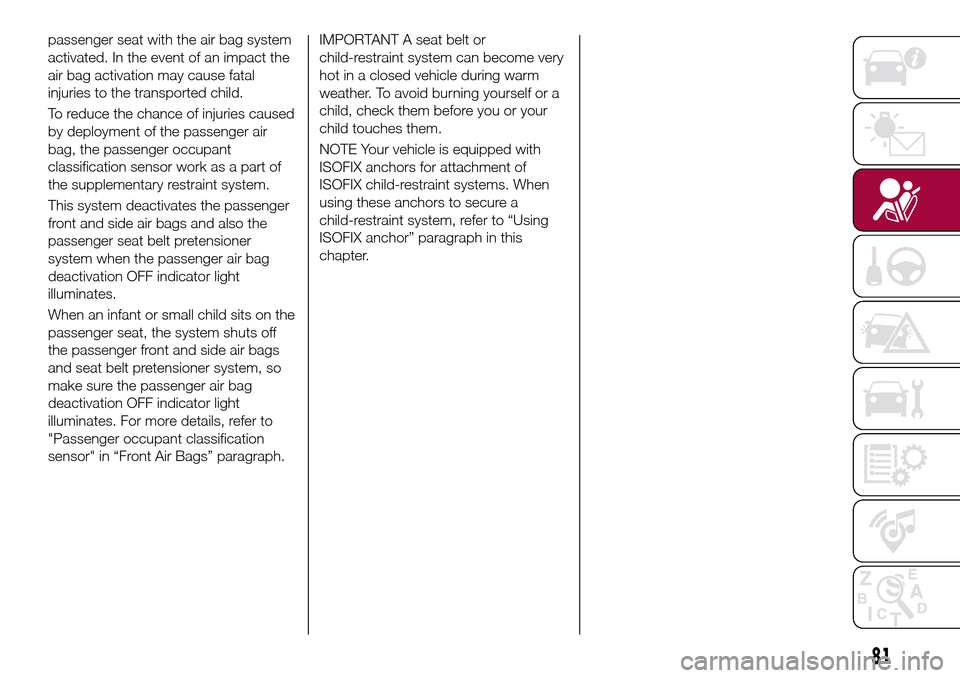
passenger seat with the air bag system
activated. In the event of an impact the
air bag activation may cause fatal
injuries to the transported child.
To reduce the chance of injuries caused
by deployment of the passenger air
bag, the passenger occupant
classification sensor work as a part of
the supplementary restraint system.
This system deactivates the passenger
front and side air bags and also the
passenger seat belt pretensioner
system when the passenger air bag
deactivation OFF indicator light
illuminates.
When an infant or small child sits on the
passenger seat, the system shuts off
the passenger front and side air bags
and seat belt pretensioner system, so
make sure the passenger air bag
deactivation OFF indicator light
illuminates. For more details, refer to
"Passenger occupant classification
sensor" in “Front Air Bags” paragraph.IMPORTANT A seat belt or
child-restraint system can become very
hot in a closed vehicle during warm
weather. To avoid burning yourself or a
child, check them before you or your
child touches them.
NOTE Your vehicle is equipped with
ISOFIX anchors for attachment of
ISOFIX child-restraint systems. When
using these anchors to secure a
child-restraint system, refer to “Using
ISOFIX anchor” paragraph in this
chapter.
81
Page 84 of 216
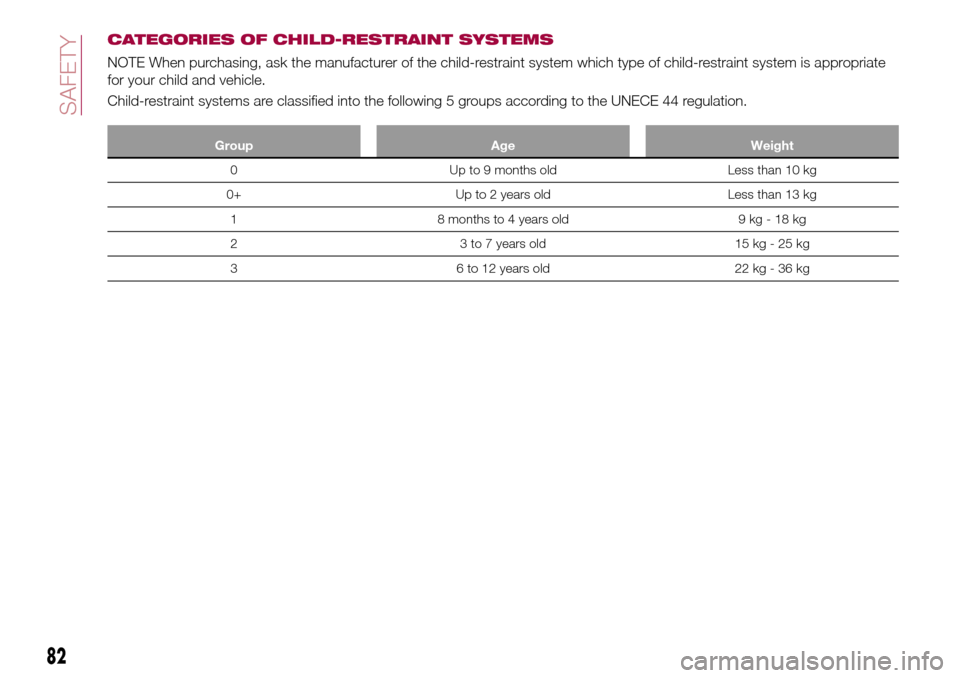
CATEGORIES OF CHILD-RESTRAINT SYSTEMS
NOTE When purchasing, ask the manufacturer of the child-restraint system which type of child-restraint system is appropriate
for your child and vehicle.
Child-restraint systems are classified into the following 5 groups according to the UNECE 44 regulation.
Group Age Weight
0 Up to 9 months old Less than 10 kg
0+ Up to 2 years old Less than 13 kg
1 8 months to 4 years old 9 kg - 18 kg
2 3 to 7 years old 15 kg - 25 kg
3 6 to 12 years old 22 kg - 36 kg
82
SAFETY
Page 85 of 216
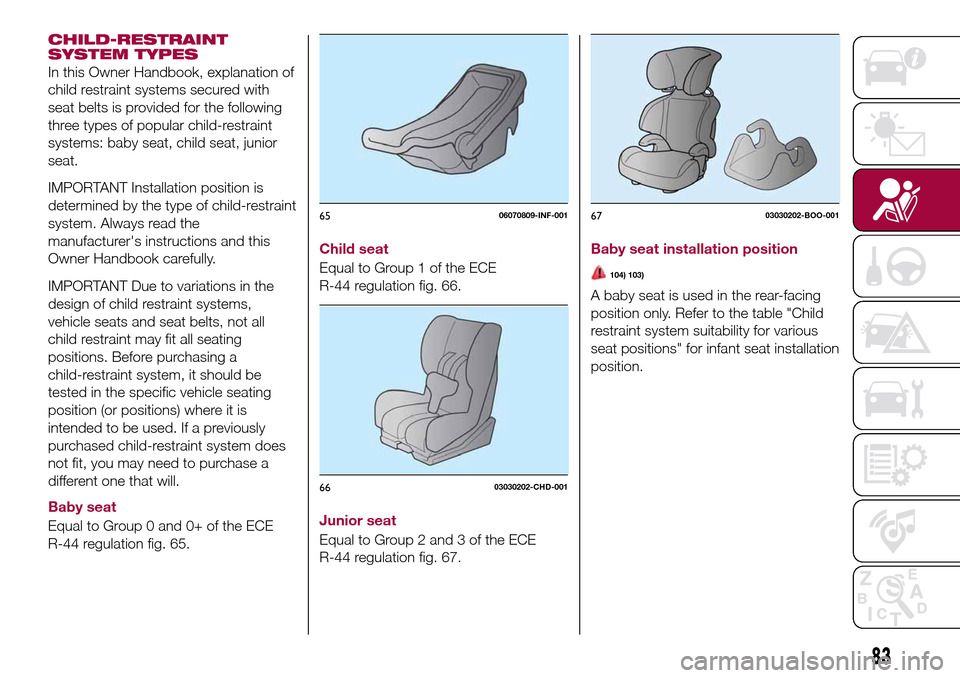
CHILD-RESTRAINT
SYSTEM TYPES
In this Owner Handbook, explanation of
child restraint systems secured with
seat belts is provided for the following
three types of popular child-restraint
systems: baby seat, child seat, junior
seat.
IMPORTANT Installation position is
determined by the type of child-restraint
system. Always read the
manufacturer's instructions and this
Owner Handbook carefully.
IMPORTANT Due to variations in the
design of child restraint systems,
vehicle seats and seat belts, not all
child restraint may fit all seating
positions. Before purchasing a
child-restraint system, it should be
tested in the specific vehicle seating
position (or positions) where it is
intended to be used. If a previously
purchased child-restraint system does
not fit, you may need to purchase a
different one that will.
Baby seat
Equal to Group 0 and 0+ of the ECE
R-44 regulation fig. 65.Child seat
Equal to Group 1 of the ECE
R-44 regulation fig. 66.
Junior seat
Equal to Group 2 and 3 of the ECE
R-44 regulation fig. 67.Baby seat installation position
104) 103)
A baby seat is used in the rear-facing
position only. Refer to the table "Child
restraint system suitability for various
seat positions" for infant seat installation
position.
6506070809-INF-001
6603030202-CHD-001
6703030202-BOO-001
83
Page 86 of 216
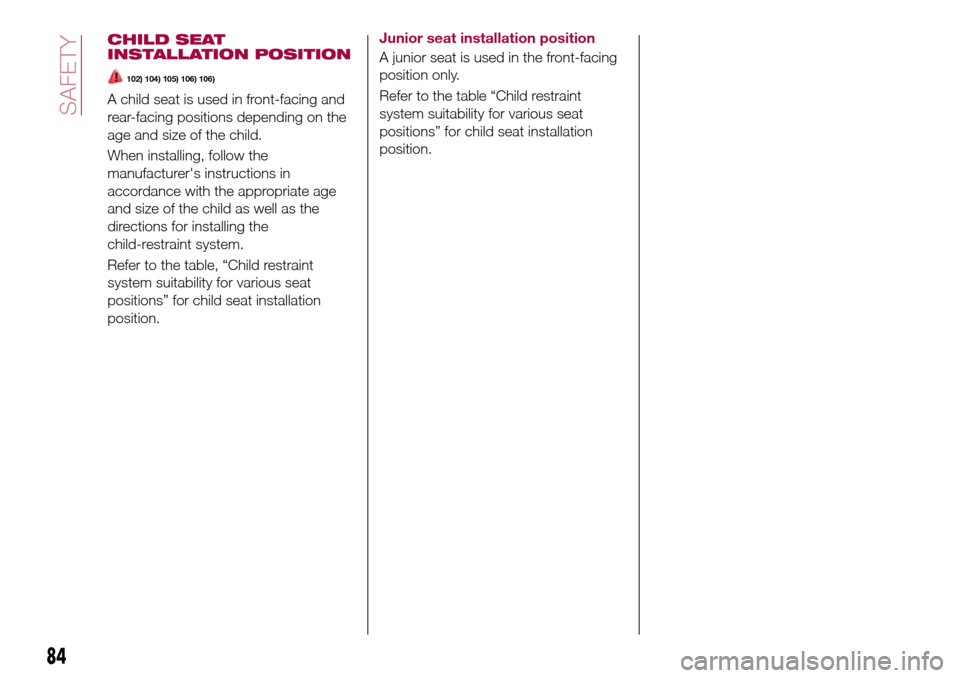
CHILD SEAT
INSTALLATION POSITION
102) 104) 105) 106) 106)
A child seat is used in front-facing and
rear-facing positions depending on the
age and size of the child.
When installing, follow the
manufacturer's instructions in
accordance with the appropriate age
and size of the child as well as the
directions for installing the
child-restraint system.
Refer to the table, “Child restraint
system suitability for various seat
positions” for child seat installation
position.Junior seat installation position
A junior seat is used in the front-facing
position only.
Refer to the table “Child restraint
system suitability for various seat
positions” for child seat installation
position.
84
SAFETY
Page 87 of 216
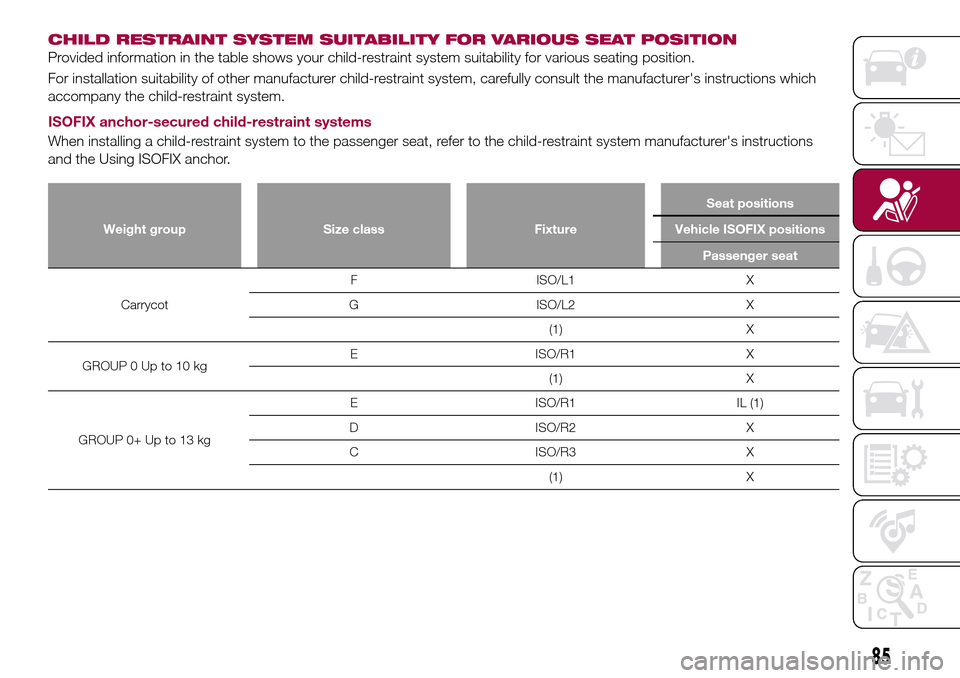
CHILD RESTRAINT SYSTEM SUITABILITY FOR VARIOUS SEAT POSITION
Provided information in the table shows your child-restraint system suitability for various seating position.
For installation suitability of other manufacturer child-restraint system, carefully consult the manufacturer's instructions which
accompany the child-restraint system.
ISOFIX anchor-secured child-restraint systems
When installing a child-restraint system to the passenger seat, refer to the child-restraint system manufacturer's instructions
and the Using ISOFIX anchor.
Weight group Size class FixtureSeat positions
Vehicle ISOFIX positions
Passenger seat
CarrycotF ISO/L1 X
G ISO/L2 X
(1) X
GROUP 0 Up to 10 kgE ISO/R1 X
(1) X
GROUP 0+ Up to 13 kgE ISO/R1 IL (1)
D ISO/R2 X
C ISO/R3 X
(1) X
85
Page 88 of 216
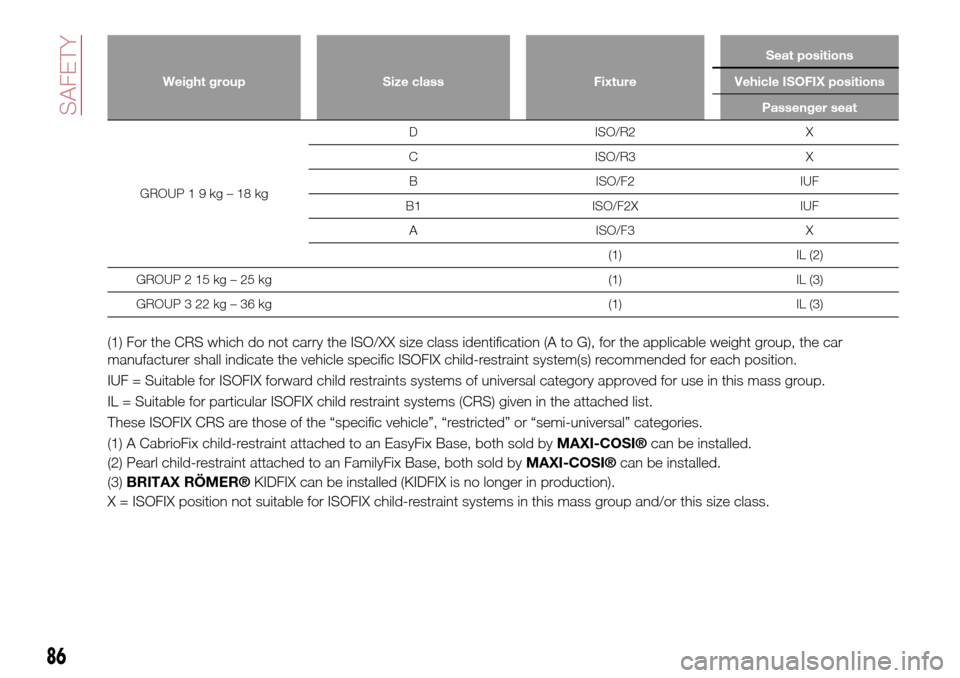
Weight group Size class FixtureSeat positions
Vehicle ISOFIX positions
Passenger seat
GROUP19kg–18kgD ISO/R2 X
C ISO/R3 X
B ISO/F2 IUF
B1 ISO/F2X IUF
A ISO/F3 X
(1) IL (2)
GROUP 2 15 kg – 25 kg (1) IL (3)
GROUP 3 22 kg – 36 kg (1) IL (3)
(1) For the CRS which do not carry the ISO/XX size class identification (A to G), for the applicable weight group, the car
manufacturer shall indicate the vehicle specific ISOFIX child-restraint system(s) recommended for each position.
IUF = Suitable for ISOFIX forward child restraints systems of universal category approved for use in this mass group.
IL = Suitable for particular ISOFIX child restraint systems (CRS) given in the attached list.
These ISOFIX CRS are those of the “specific vehicle”, “restricted” or “semi-universal” categories.
(1) A CabrioFix child-restraint attached to an EasyFix Base, both sold by
MAXI-COSI®can be installed.
(2) Pearl child-restraint attached to an FamilyFix Base, both sold by
MAXI-COSI®can be installed.
(3)
BRITAX RÖMER®KIDFIX can be installed (KIDFIX is no longer in production).
X = ISOFIX position not suitable for ISOFIX child-restraint systems in this mass group and/or this size class.
86
SAFETY
Page 89 of 216
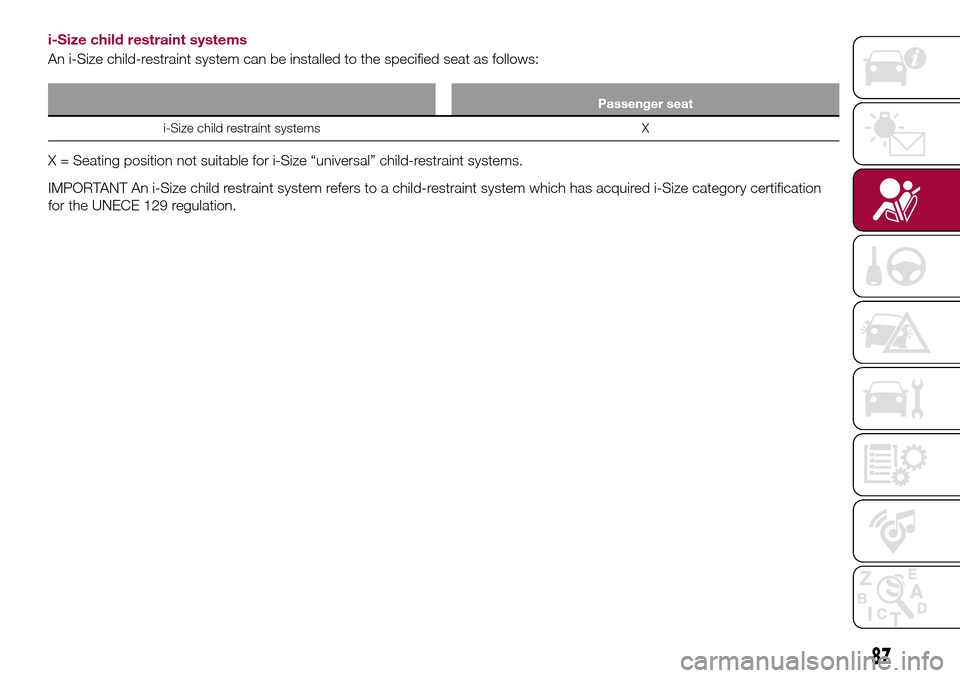
i-Size child restraint systems
An i-Size child-restraint system can be installed to the specified seat as follows:
Passenger seat
i-Size child restraint systems X
X = Seating position not suitable for i-Size “universal” child-restraint systems.
IMPORTANT An i-Size child restraint system refers to a child-restraint system which has acquired i-Size category certification
for the UNECE 129 regulation.
87
Page 90 of 216
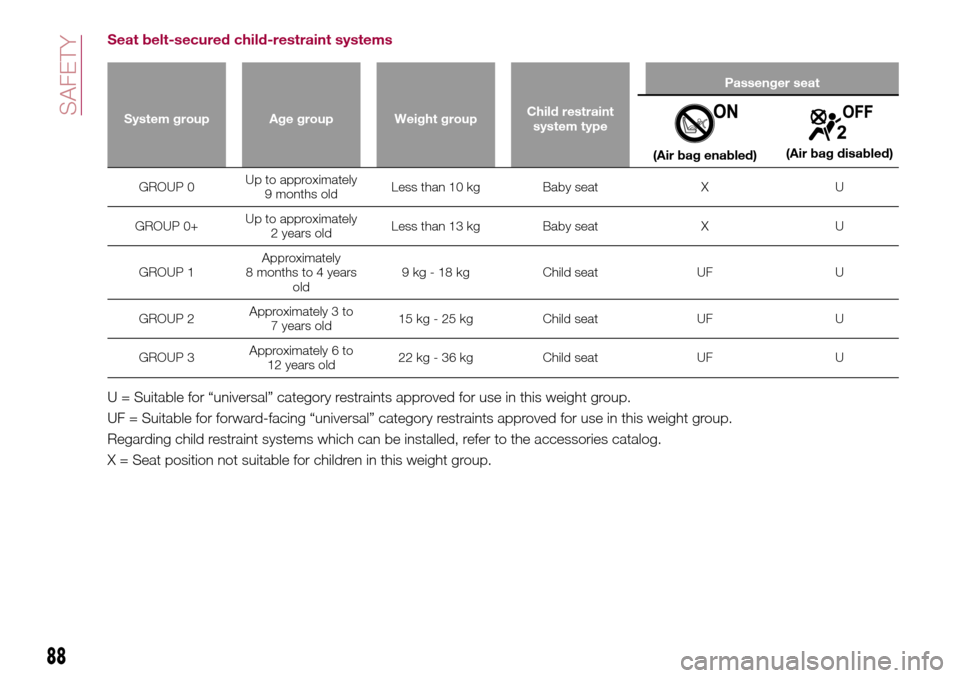
Seat belt-secured child-restraint systems
System group Age group Weight groupChild restraint
system typePassenger seat
(Air bag enabled)(Air bag disabled)
GROUP 0Up to approximately
9 months oldLess than 10 kg Baby seat X U
GROUP 0+Up to approximately
2 years oldLess than 13 kg Baby seat X U
GROUP 1Approximately
8 months to 4 years
old9 kg - 18 kg Child seat UF U
GROUP 2Approximately 3 to
7 years old15 kg - 25 kg Child seat UF U
GROUP 3Approximately 6 to
12 years old22 kg - 36 kg Child seat UF U
U = Suitable for “universal” category restraints approved for use in this weight group.
UF = Suitable for forward-facing “universal” category restraints approved for use in this weight group.
Regarding child restraint systems which can be installed, refer to the accessories catalog.
X = Seat position not suitable for children in this weight group.
88
SAFETY